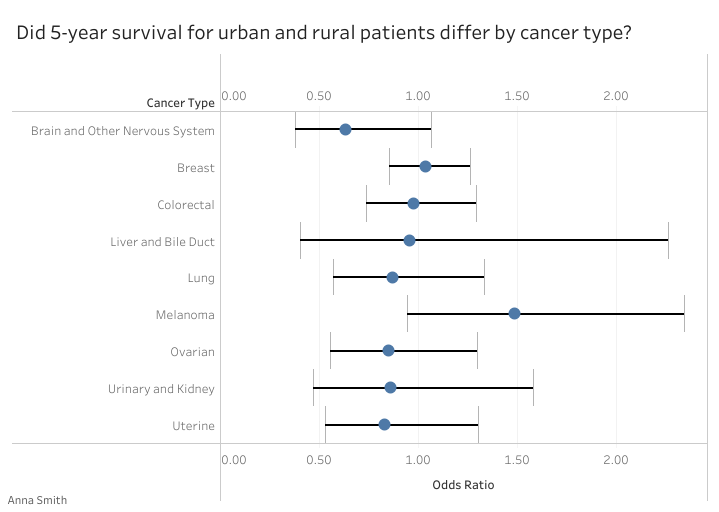Survivorship differences between urban and rural participants with solid tumors

Anna Smith
Master’s Student, Online MPH in Population and Health Sciences
 This article was originally published in the California Teachers Study blog.
This article was originally published in the California Teachers Study blog.
Online MPH student Anna Smith recently collaborated with the California Teachers Study (CTS) research team to uncover whether there were differences in five-year cancer survivorship between urban and rural residents. By delving into this vital area of public health, she aimed to contribute to a clearer understanding of how geographical location impacts cancer outcomes.
Her research was conducted as part of the online MPH’s Applied Practicum Experience (APEx) capstone project, in which students work with community organizations to support real public health work. Smith was one of a handful of online MPH students chosen to work remotely with CTS to explore various research questions using the study's broad data set. In this blog, she shares her research methodology, key findings, and the implications for future studies addressing cancer survivorship disparities.
The goal of my research project was to explore whether there were differences in five-year cancer survivorship between urban and rural residents in the California Teachers Study (CTS). Five-year survivorship means the percentage of patients who are still alive five years after they are diagnosed with cancer.
Previous studies on this topic have varied in their results. Some research has shown that rural residence and being a further distance from a healthcare provider is associated with higher rates of death, being diagnosed with cancer at a later stage, and having worse cancer-specific mortality. However, these results differ by cancer type, and other research studies did not find significant differences in survival by urban or rural residence.
My project looked at whether five-year survivorship differed between urban and rural participants with solid tumor cancers. Solid tumor cancers are cancers where the mass of cells clumps together (in contrast to a cancer like leukemia, which does not form a solid mass). I calculated five-year survival for urban and rural participants who had been diagnosed with a solid tumor and then compared those results.
What I Found
The results from my project suggest that five-year survival did not differ between
urban and rural CTS participants who had breast, uterine, ovarian, lung, colorectal,
liver, or urinary and kidney cancer. While many of my results did show a trend where
five-year survival appeared to be lower for the rural group than the urban group,
none of these results were statistically significant. If a result is not statistically
significant, that means the trend we are seeing may be due to chance.
"Did 5-year survival for urban and rural patients differ by cancer type?" by Anna Smith View on Tableau Public
The chart above shows the results for each cancer type. At first glance, five-year survival looks different for urban and rural melanoma patients. However, when we hover over the line for melanoma, we can see the lower and upper confidence intervals (CI) for each odds radio. An odds ratio measures the relationship between an exposure and outcome. A confidence interval tells us how precise that measurement is.
For melanoma, the lower CI is 0.94 and the upper CI is 2.34. In a statistical analysis, a confidence interval that includes 1.0 tells us that the odds ratio is not statistically meaningful. Because the confidence interval of 0.94 to 2.34 includes 1.0, there was not a difference in five-year survival between urban and rural melanoma patients.
What Comes Next
To further explore potential differences in urban and rural cancer survivorship among CTS participants, future projects could consider doing a multivariate analysis. A multivariate analysis considers multiple variables all at once. For instance, my project showed that five-year survival did not differ between urban and rural participants for the cancers I examined. However, my analysis did not account for how other factors—like participant age, socioeconomic status, and lifestyle factors—may affect survivorship. A multivariate analysis could help identify those nuances and answer the question “Does five-year survival differ between urban and rural participants when we also take into account participant age, socioeconomic status, and other lifestyle factors?”
About the Author
 Anna Smith is a second-year graduate student in the Population and Health Sciences
online MPH program at the University of Michigan. She’s previously worked in community
health both in the United States and abroad. In the future, she hopes to explore how
neighborhoods and where we spend time affect health outcomes, and how data-backed
solutions can be applied to improve population health.
Anna Smith is a second-year graduate student in the Population and Health Sciences
online MPH program at the University of Michigan. She’s previously worked in community
health both in the United States and abroad. In the future, she hopes to explore how
neighborhoods and where we spend time affect health outcomes, and how data-backed
solutions can be applied to improve population health.
"Working with the CTS team was an invaluable experience and allowed me to gain knowledge in data analysis and how to work within a research team."
